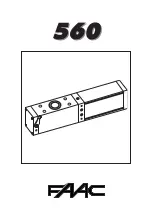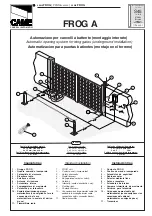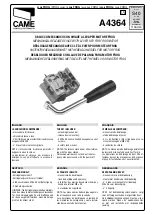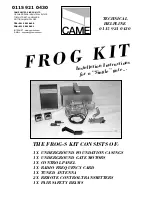
ENG
LI
SH
16
Make sure that neither persons nor objects are in the path of the door.
If possible, the door should only be operated when there is visual con-
tact with the movement range of the door.
Monitor the door movement until the door has reached its end position.
During opening and closing of the gate, the working area of the gate sys-
tem must
not be entered or passed through!
Do not stand still in the opened door system!
If possible, install an emergency stop command device in order to be
able to trigger an immediate stop in an emergency.
WARNING
Risk of injury on the gear rack
During gate run, limbs and fingers may be pinched, crushed or severed be-
tween the gear wheel and the gear rack!
SAFETY INSTRUCTION FOR DANGER AVOIDANCE
Do not touch the gear wheel or gear rack while the gate is moving.
Make sure that children
do not touch the gear wheel or gear rack while
the gate is moving.
If possible, the gate should only be operated when there is visual con-
tact with the movement range of the gate.
If possible, install an emergency stop command device so that an imme-
diate stop can be activated in an emergency.
CAUTION!
During all learning trips, the gate must not be stopped by light barriers, safety
contact strips or anything else or prevented from running
normally.
After plugging the Schuko plug into the 230 V socket, the control unit carries
out a self-diagnosis, indicated by red flashing, approx. 3 seconds after this the
green mains LED lights up.
The drive and the controls learn its force requirement and its soft run them-
selves. For this purpose,
learning runs must be performed. Move the gate a
total of four times from limit switch to limit switch by pressing the pulse button
on the motor control unit. The gate must not be stopped by radio or by the
pushbutton during these learning travels!
17
The force requirement of the gate was determined during the learning runs.
A reserve was added to this force requirement. If the reserve is not sufficient,
you can increase the value in both directions at the two potentiometers "Force
open" and "Force closed".
1100..
AAnntteennnnaa ccoonnnneeccttiioonn
NOTE
The rod antenna should be assembled at the highest possible position, an as-
sembly in the radio shadow is to be avoided!
In the terminal 6, in the screw terminal connection on the board is connected a
throw antenna. In order to achieve an optimum range, this must be led out of
the housing.
Alternatively, the core of a rod antenna can be connected to terminal 6.
The shielding must not be connected to terminal 7.
1111..
TTeeaacchhiinngg--iinn ooff tthhee rraaddiioo ccooddeess
NOTE
DIP switches on the motor control are only for program selection, NO radio
coding!
In the handheld transmitters, all dip switches are set to OFF or ON. This means
that each handheld transmitter has its own individual security code. You can
teach this safety code into the motor control unit. Up to 49 codes can be taught
in. You can also set a code by setting four of the ten dip switches in the hand-
held transmitter to ON. In this way, you have the same coding for all handheld
transmitters on a particular system.
To teach in the coding, press the "Radio" key on the motor control unit for ap-
prox. half a second. The yellow LED starts to flash once at intervals of 2 sec-
onds. You now have approx. 15 seconds to program the desired key of the
handheld transmitter. Press the desired transmitter key until the flashing of the
yellow LED becomes a continuous light. If the yellow LED switches to continu-
ous light, the receiver has stored the coding.
















































